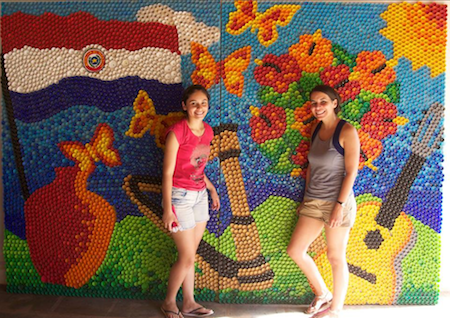If you have a group of volunteers, youth program participants, board members, or staff that need a teambuilding exercise, and you are thinking about involving them in an art project but you have little funding, resources, or artistic ability, try a project anyone can do on a small budget with a little bit of patience!
Bottle cap art projects have become quite trendy throughout the world, especially within youth and school groups that want to make a green statement. The tops of plastic bottles aren’t always recyclable, and their litter impact is a known contributor of nonpoint source pollution to waterways and oceans.
But the primary reason they are so popular is because anyone can do them – it takes a bit of creative design work, and patience to collect bottle caps, but it is in essence paint-by-number on a big plank board with a drill press or glue. And, unlike other murals, they are not integrated directly onto a wall and hence portable for different display spaces.
This article’s aim is not to give you step-by-step directions on how to make a mural – dozens of DIY articles are already available on the web to that end (see below). The aim, instead, is to help you think about taking your art project to the next level and using it to market or fundraise for your nonprofit. Teambuilding for your organization’s volunteers, staff, or program recipients is a great project goal in and of itself, but making money or attracting new members and donors too is even better!

Bootle cap mural by youth group in Paraguay
(Image used with permission)
1. Getting Started
Here are three fantastic resources to inspire you and give step-by-step directions on how to make a mural: 1) an international project in the interior of Paraguay to bring a youth group together, now hanging in the state government office building (see picture above); 2) a slideshow of different murals from a school in Arkansas with different themes for different class levels; and 3) a teacher’s blog on her process of engaging younger students in simple designs and using glue instead of drills.
In short, you need to:
- Collect bottle caps;
- Wash them thoroughly;
- Buy or get via donation a big plywood board;
- Draw a rough design with your group’s input integrating the bottle cap colors and sizes you have collected; and
- Drill or glue the caps!
Your budget will be well under $500 for the entire project.
2. How to Market Your Bottle Cap Mural
You can very easily use your art project to make a statement and attract attention to a specific cause of your organization, to attract new volunteers, or just to get publicity help in fundraising.
- Make the mural theme a part of your organizational story. If you are an animal shelter, for example, design a picture of a Dalmatian with colorful spots (black bottle caps are rare) and make a community pitch for bottle caps, particularly white ones, via press releases and postering at local universities. You can add your mission at the end of the press release, for basic advertising, or volunteering information if your agenda is to find new help.
- Advertise your greenness by highlighting the fact that many lids are still non-recyclable and end up in landfills or on the ground as litter. You can send out a press release asking the public to collect and bring in their lids too, advertising the waste each household contributes annually by throwing away bottle caps, or work with a local school or Girl Scouts group on the collecting aspect. Those additional participants will help bring more buzz to the project and contribute to your social marketing campaign.
- Make a movie throughout the creation process. At the end of the movie, make a simple “help us do this again” message with a pitch for a small donation ($5 or $10). Post that movie to your YouTube channel, Facebook page, and website. Many social media sites have groups for crafting as well where you can post to get more views (like this one on Pinterest), or search for “bottle cap murals” on Pinterest.
- Put it on display on rotation at different local buildings with your story. Before you even start the project, you can organize a display rotation schedule at different local schools, municipal buildings, or commercial businesses like supermarkets or local hotels. You will want to include a small plaque or printed takeaway with mural facts (how many caps were used, how many people participated, etc.) and organizational contact information to accompany the mural.
3. Direct Fundraising: Sell Your Mural!
You can make the project itself a fundraising campaign by auctioning it, raffling it, or any other number of publicity stunts. If a school class helps collect caps, for example, you can ask a local corporation to match each cap collected by $5. You could raise up to $5,000 that way, from a funding source that otherwise would not have contributed to your cause!
A bottle cap mural can be an engaging, inexpensive, and green way to accomplish 1) a teambuilding activity for your members, volunteers, and staff; 2) organizational advertising and community marketing; and 3) direct fundraising for your work, even for the artistically challenged!
